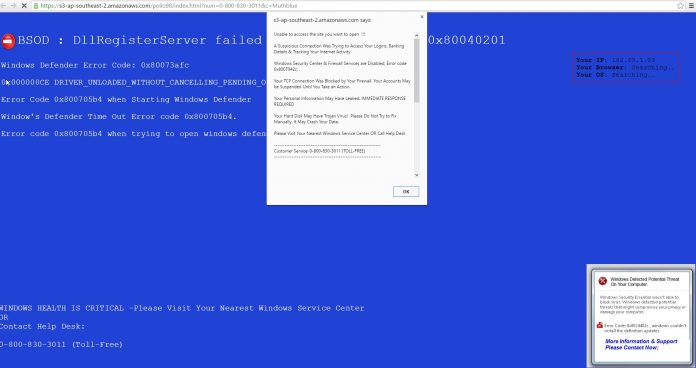
The Amazonaws Virus, which affects Amazon S3 (Simple Storage Service), has been around since at least 2011. The virus affects Amazon S3 (Simple Storage Service), an online file storage web service owned by Amazon.com and offered by its Amazon Web Services subsidiary.
With a medium danger level, the malware has caused the Amazon service to get flagged as a potential computer virus. Symptoms include many website redirects when clicking on a link inside Amazon S3 as well as unwanted pop-up ads on the site.
Featuring the classic signs of a browser hijacker, several browsers such as Chrome and Firefox have labeled the service unsafe or malicious. Malicious files stored on Amazon S3 is most probably the Amazonaws’ distribution method as users can upload anything they want to the cloud.
Amazon launched its cloud-based storage service in the United States in March 2006. As of April 2013, it already stored more than 2 trillion objects. Costumers use S3 for web hosting, image hosting, and storage for backup systems.

How to remove the Amazonaws from web browsers
Reboot the Windows PC in Safe Mode. Next, they have to remove the malware from all web browsers installed on their computer.
For Internet Explorer, they have to open it, click Manage Add-ons, and look for Amazonaws Virus. Press disable, and it will go away. For Firefox users have to open it, then Add-ons/Extensions. Find Amazonaws Virus and remove it.
For Chrome they have to start the Google browser first. Next, go to More Tools/Extensions. Locate the malware and press remove. Proceed to Settings/Search/Manage Search Engines to delete everything except the search engines they regularly use.
For Safari users have to open it, then right-click on the browser’s shortcut. Hit Properties/Shortcut/Target. Remove everything after .exe.

How to remove the virus from Windows PC
Once done with the browsers, hold the Start Key and R together. Type appwiz.cpl and click OK to enter the Control Panel. Search for Amazonaws Virus and suspicious programs to uninstall them.
Hold the Start Key and R again. Copy and paste the following: notepad %windir%/system32/Drivers/etc/hosts, then click OK. A .txt file will open. If below “Localhost” there are other IPs connected, it means users got hacked.
The next step is to right-click Taskbar/Start Task Manager to open the Task Manager. Once it starts, select the Processes Tab. Right click on every virus process one at a time and choose Open File Location. Then click End Process after opening the folder.
Finally, write Msconfig in the search field and hit Enter to get to a pop-up window. Select the Startup tab as well as Uncheck entries featuring Unknown as Manufacturer. Type Regedit in the search field and press Enter.
Press CTRL and F together, then write Amazonaws Virus. Right-click and delete all entries with the name of the virus or similar.
How to remove the Amazonaws Virus for Android users
Signs of a malware infection, like the Amazonaws Virus, in Android devices, are different. They include poor battery life, call quality issues, ghost SMS messages, data plan spike usage, and deficient overall performance.
Usually, users who install apps outside of Google Play are more vulnerable to Android malware. The safest way to avoid getting infected is to download apps from Google’s app store. Another less safe option is to download an .APK file from several locations.
If infected users must go to Settings/More/Application Manager/All. Locate the default Internet App or Chrome. Up next, both Internet and Chrome users have to click the Force Stop button, followed by those of Clear Data and Clear Cache.
Restart the browser or Reboot the Android device. Users can do both as well. Then remove strange Android apps by clicking Settings menu/Apps. Choose the app and tap the Uninstall button. If grayed out, go to Settings/Security/Device Administrators. Look for the problematic app under Android DeviceManager and remove it. Now go back to Settings Menu/Apps, select the app and press the Uninstall button.
Source: Virus Removal











I use an iPhone 6 with iOS10.2.1. I noticed some delays in uploading several sites when using Safari.
I cleared History and Website data and then I checked in Settings > Safari > Advanced > Website Data and there was amazonaws.com only.
I deleted it but it is still there. I restarted the phone – It is still there.
Is this a virus? Is it harmful for my phone? If yes, how can I get rid of it?
Thanks in advance for your inputs.